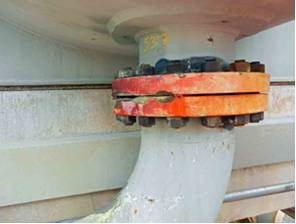
Incident Report Subject: U.S. CSB - CITGO Refinery HF Release - STATEMENT BY TEAM LEAD JOHNNIE BANKS Date of Email report: Sat 17/03/2012 Report Detail:
The fire, which burned for several days, critically injured one employee and another was treated for possible HF exposure. As a result of the 2009 accident, CITGO reported to the Texas Commission on Environmental Quality that approximately 21 tons of HF released from alkylation unit piping and equipment. Since arriving in Corpus Christi on March 6th the CSB investigation teams have conducted about 20 interviews, examined the accident scene and designed testing to estimate the total amount of process stream that was released to the atmosphere during the March 5th incident. The March 5th leak occurred due to the failure of the seal on a 12 inch flange on a process vessel in the Alkylation unit. These photos are a close-up of the flange that failed. As you can see from the photos the flange is a distinct red color. The paint on the flange turns red when it comes in contact with even a small quantity of acid. Following a maintenance activity the flange is washed with a caustic solution which returns it to its original color so that subsequent leaks can be identified. To date, our investigation has found that the March 5th release can be traced to leaks at this flange reported as far back as September 2011. In late January of this year, maintenance was performed on the flange, tightening the existing bolts, but the leak persisted. Further maintenance was performed on February 10 – over three weeks prior to the actual incident. At that time workers replaced the flange bolts and a work order was submitted to order a clamp to enclose the leak. The unit was not shut down; rather the clamp was ordered in the hopes that its installment would stop the leak. The proposed design of the new clamp was rejected three times over the next three weeks and had not been installed by March 5th. On the day of the incident the leak from the piping flange on the 12-inch line worsened. Process liquids containing hydrocarbons and about 5% HF were released in a steady stream which worsened through the late afternoon. The CSB has determined that the March 5th incident resulted in the release of between 300 and 500 pounds of HF. Eventually, the release was detected by sensors that triggered the alkylation unit’s automatic water cannons, designed to capture airborne HF. Automatic water cannons are intended as the last line of defense in the event of a release of HF. Our investigative team has discovered that the water cannons were once again activated by an HF release on March 10th and 11th as the refinery was restarting the unit. The events that took place on March 10th and 11th were planned work activities AND the company was aware that the water cannons might be triggered. Although the two additional releases were small in quantity the CSB is concerned that management accepted that the water cannons could be triggered. The facility is routinely using the water cannons as release mitigation for maintenance activities when in reality they should not be used as the last line of defense. Moving forward the CSB will be examining commonalities between the 2009 HF release and the March 5th incident. The facility’s continued reliance on the water cannons to “control” an HF release raises serious concerns regarding the facility’s management systems and control. The CSB’s investigations seek to identify the root cause of an accident. As new information becomes available, we will keep the community, public officials and the industry informed. We do all this, of course, in an effort to prevent serious chemical and refinery accidents that cause injuries, destroy property, and jeopardize public safety. Our ultimate product will include safety recommendations designed to prevent a recurrence of this type of accident, here or at refineries located in cities across the country. CITGO’s workers and its neighbors have a right to know that their safety is an important consideration during the daily operations of this refinery.
Additional Documentation:
|

